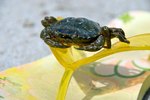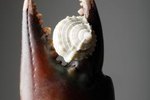The scientific names for king crab species are Paralithodes camtshaticus for the red king crab, Paralithodes platypus for the blue king crab, Lithodes aequispinus for the golden king crab and Lithoes couesi for the scarlet king crab, according to the Sea Choice website. King crabs have a calcified exoskeleton with spines. The head and thorax of this crab are fused together. King crabs have fan-shaped tails and five sets of appendages. Two of these appendages are pinchers and the right pincher is usually slightly larger than the left pincher. The other three appendages are legs used for walking.
Age
King crabs typically live between 20 and 30 years. However, king crabs reach maturity between four and seven years of age.
Considerations
There are three types of king crabs commonly sold in the seafood industry. Crabs are capable of living in extremely cold environments such as the continental shelf. The red king crab is the most common type of crab that’s sold commercially in the seafood industry. The larvae of king crabs consume algae and phytoplankton. Small crabs tend to eat sea stars, kelp, clams, mussels and barnacles. Adult king crabs are omnivores and eat whatever food is available in shallow waters. Adult king crabs are extremely active and will migrate rapidly if there is not enough food in an area.
Size
The king crab is one of the largest arthropods on earth, according to Nobanis.org. These crabs typically way over 10 kg and grow up to 22 cm in length.
Geography
The king crab is found in the Okhotsk Sea, Japan Sea, Bering Sea and Northern Pacific Ocean, according to Nobanis.org. Specific locations include Korea, Aleutian island chain, Norton Sound, Alaska, the Great Bay, the eastern coast of Siberia and the Kamchatka peninsula coasts.
Habitat
King crabs usually lay their larvae in shallow waters, according to Nobanis.org. Adult king crabs are typically found on mud and sand substrata. King crabs must live in a region where the spring phyto- and zoo-plankton peaks are synchronized. The survival of the king crab in shallow waters depends primarily on the amount of cover that’s available.
Reproduction
King crabs carry out two migrations, according to Nobanis.org. These migrations include a mating-molting and a feeding migration. During the summer and autumn months, king crabs move into deeper waters. In the spring, king crabs move to shallow waters to mate and hatch their eggs.
References
Photo Credits
-
crab image by Vaclav Janousek from Fotolia.com
Writer Bio
Laurence Girard has been writing professionally since 2006. Girard is currently a pre-med student at the Harvard University Extension School.





